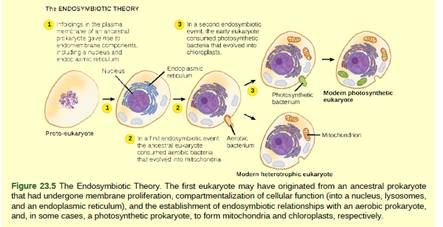
Concept explainers
Figure 23.5 What evidence is there that mitochondria were incorporated into the ancestral eukaryotic cell before chloroplasts?

To analyze:
Evidence that suggests mitochondria were incorporated into the ancestral eukaryotes before chloroplasts.
Introduction:
Mitochondria and chloroplast are believed to have evolved as a result of endosymbiosis. The chloroplasts from cyanobacteria that was internalized by larger Archean and mitochondria from a proto aerobic bacterium.
Explanation of Solution
The evidence that mitochondria were incorporated much before chloroplasts in the ancestral eukaryotes is that while mitochondria are found in all the eukaryotes chloroplast is found only in green plants that are capable of producing their own food by photosynthesis.
Mitochondria are believed to have been internalized before the chloroplast, which is evident from the fact that mitochondria are found in all the eukaryotic organisms while chloroplast is not.
Want to see more full solutions like this?
Chapter 23 Solutions
Biology 2e
Additional Science Textbook Solutions
Campbell Biology (11th Edition)
Genetic Analysis: An Integrated Approach (3rd Edition)
Human Physiology: An Integrated Approach (8th Edition)
Microbiology with Diseases by Body System (5th Edition)
Chemistry: A Molecular Approach (4th Edition)
Microbiology: An Introduction
- Species Interactions Explain how predators, prey and scavengers interact. Explain whether predators and scavengers are necessary or beneficial for an ecosystem.arrow_forwardmagine that you are conducting research on fruit type and seed dispersal. You submitted a paper to a peer-reviewed journal that addresses the factors that impact fruit type and seed dispersal mechanisms in plants of Central America. The editor of the journal communicates that your paper may be published if you make ‘minor revisions’ to the document. Describe two characteristics that you would expect in seeds that are dispersed by the wind. Contrast this with what you would expect for seeds that are gathered, buried or eaten by animals, and explain why they are different. (Editor’s note: Providing this information in your discussion will help readers to consider the significance of the research).arrow_forwardWhat is the difference between Uniporters, Symporters and Antiporters? Which of these are examples of active transport?arrow_forward
- What are Amyloid Fibrils? What biological functions are these known to perform?arrow_forwardHow do histamine and prostaglandins help in the mobilization of leukocytes to an injury site? What are chemotactic factors? How do they affect inflammation process?arrow_forwardCompare and contrast neutrophils and macrophages. Describe two ways they are different and two ways they are similar.arrow_forward
- Describe the effects of three cytokines (not involved in the initial inflammation response). What cells release them?arrow_forwardDescribe activation of helper T cells or cytotoxic T cellsarrow_forwardCompare and contrast MHC 1 and MHC 2. Describe two way they are different and two ways they similar including how they are used in antigen presentation.arrow_forward
 Biology 2eBiologyISBN:9781947172517Author:Matthew Douglas, Jung Choi, Mary Ann ClarkPublisher:OpenStax
Biology 2eBiologyISBN:9781947172517Author:Matthew Douglas, Jung Choi, Mary Ann ClarkPublisher:OpenStax Biology: The Dynamic Science (MindTap Course List)BiologyISBN:9781305389892Author:Peter J. Russell, Paul E. Hertz, Beverly McMillanPublisher:Cengage Learning
Biology: The Dynamic Science (MindTap Course List)BiologyISBN:9781305389892Author:Peter J. Russell, Paul E. Hertz, Beverly McMillanPublisher:Cengage Learning

